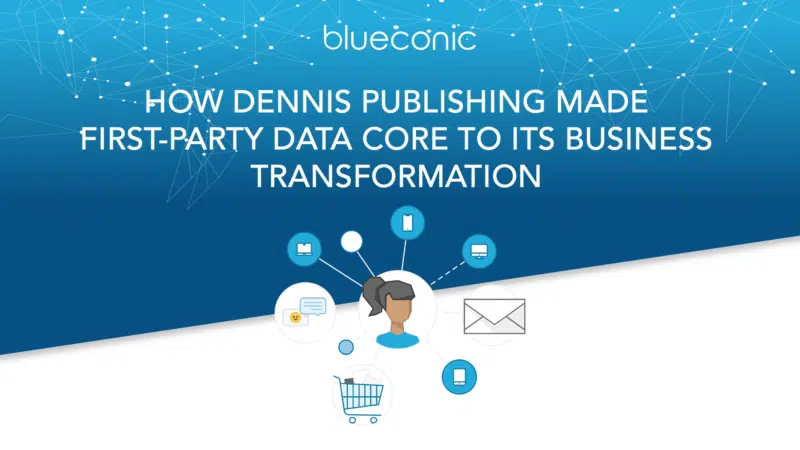Opinions expressed in this article are those of the sponsor. Search Engine Land neither confirms nor disputes any of the conclusions presented below.
How Dennis Publishing made first-party data core to its business transformation
Chief product & data officer explains how the company is unlocking the power of first-party data to drive growth across the business.

While many companies struggled to adapt during the pandemic, Dennis Publishing, the parent company of popular media brands like Kiplinger, The Week, several automotive publications, among others, decided to prioritize business transformation and find new ways to drive growth through audience monetization. And its strategy is paying off.
In a recent session at the MarTech Fall Conference, Dennis Publishing’s chief product & data officer, Pete Wootton, joined Jackie Rousseau-Anderson of customer data platform BlueConic to explain how the company is scaling its first-party data strategy, including the launch of ‘Autovia,’ a business unit that combines the power of content with e-commerce to establish a highly engaged auto buying audience.
The intersection of product and data
“Customer data has become an instrumental part of our business strategy,” said Wootton, adding that the company uses the consented data it collects to understand its audiences, inform engagement, and drive growth in all areas of the business, including advertising, demand generation, subscriptions, and e-commerce. “All of these efforts are predicated on having high-quality first-party data.”
Wootton noted, however, that unifying data from across channels and systems into a single customer view is only one part of the equation. The data must also be accessible and actionable by various business teams to inform audience engagement and enhance audience-based products – something the company’s legacy data lake could not do.
“Consolidating online and offline data sources into a single customer view provides insight into who your audiences are and what they are doing,” said Wootton. While Dennis was able to collect and consolidate data from across the business in their data lake, it didn’t enable their growth-focused teams to access and activate that data with the speed, scale, and flexibility they needed to optimize customer experiences and business outcomes. “That’s when it became clear a customer data platform (CDP) would be fundamental to what we were trying to do,” he said.
Expanding CDP use cases beyond marketing
At the start of its CDP journey, Dennis Publishing had a very specific vision for how a CDP could empower its growth-focused teams. But as their knowledge of the technology grew, so did the possibilities.
“We started off with an idea of what our initial use cases would look like, but that evolved and changed over time, and we saw opportunities in certain areas that we didn’t when we began,” said Wootton.
For instance, the company originally planned to use BlueConic’s CDP to power website overlays and modals, email campaigns, and other traditional marketing techniques but quickly saw the benefit of using it to deliver more relevant, personalized, and value-driven on-site experiences.
“The elements and widgets on a particular page are now completely defined by the information we have about a particular user,” explained Wootton.
For instance, with BlueConic, the company can now suppress messaging so they don’t offer a subscription to an individual who is already a subscriber. “This may seem obvious,” Wootton continued, “but it opens up opportunities to offer a new product or do cross-sell and upsell. The real estate on your website becomes much more efficient and effective if you know who is looking at your content. When you’re able to use what you know about a person, you can take a much more targeted and personalized approach to every user on your site.”
Driving e-commerce growth through media audience monetization
Wootton also spoke about how Dennis is leveraging the first-party data it already has from the traditional publishing side of the business to drive growth for the new e-commerce side of the business. In particular, he highlighted how the company’s Autovia business unit is finding innovative ways to connect audiences with carmakers and dealers, and drive new revenue streams via audience monetization.
“We have an e-commerce business that sells cars. With a CDP, we can prioritize and promote the brands and products we offer an individual based on the content they’ve been consuming on our media sites.”
“If, for example, someone only looks for family hatchbacks or sportscars on our media sites, we can then make sure we’re promoting that sort of content on our e-commerce site because it’s much more likely to convert,” he continued. “These small changes can have big improvements in conversion, which is what we’re now seeing with BlueConic.”
Change management is an ongoing journey and company-wide effort
Wootton concluded the session by offering advice to other companies just starting their own business transformation journey. He stressed the importance of communicating the goals, use cases, timing, and expected outcomes for a CDP implementation across the business – from the senior-most leaders in the company who are making the technology purchase to the users who are actually in the platform and using it to support their day-to-day efforts.
“We spent a lot of time talking at a strategic level with the whole business about what we were trying to achieve. If you want people to be engaged, it’s the old adage – it’s about hearts and minds. You need to take them on the journey with you,” said Wootton.
For multi-brand organizations like Dennis, he also recommended starting with one or two brands and then expanding from there. “We have a broad portfolio, so we’ve decided to do a deep dive on a couple of brands rather than having a light implementation across the whole lot,” Wooten said. This implementation approach has enabled the company to zero in on the areas where they will see the highest return on investment and the biggest improvements in business performance. Going forward, their focus will be rolling out what they’ve already implemented for some of their key brands across all of the brands in their portfolio.
Related stories
New on Search Engine Land
